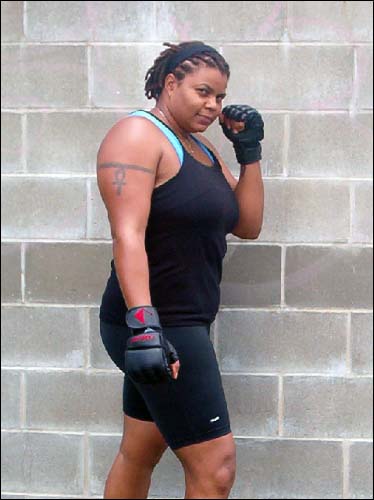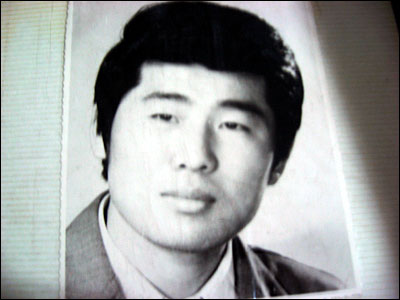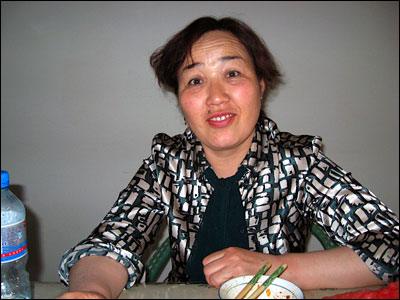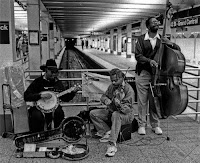
Like most other Harlem eateries, Manna’s Eighth Avenue location presents little to look at: it’s a standard two-floor affair, with the food on the first level and seating upstairs. The restaurant occupies the southernmost end of a low-rise building between 125th and 126th Streets: a red-brick edifice running almost the entire length of the block’s western edge and comprising several other establishments, all local businesses.
Just inside the entrance hangs an ornate crystal chandelier, a furnishing somewhat at odds with Manna’s predominantly utilitarian aesthetic. Once entering, patrons immediately pick up their Styrofoam clamshell carton and browse the steaming trays on the pair of glass-sheltered buffets.
Representing a broad cross section of the traditional Afro-American palate, the cuisine here includes Collard Greens Seasoned w/ Turkey Meat, Creamy Rich Baked Macaroni & Cheese, Corn & Okra ‘n’ Tomato Sauce, Manna’s Specialty B.B.Que Spare Ribs, Lima Beans Seasoned w/Ham Hocks, Honey B.B.Que Chicken Wings, Manna’s Homemade Peach Cobbler w/Homemade Crust, Southern Style Fried Chicken, Sweet Plantains, Crab Cakes, and Jamaican Style Rice & Beans, among other entrees.
Having made their selections, customers carry their food to the long stainless steel checkout counter, where Assistant Manager Philip Bulgar weighs and rings up their meal at the rate of $5.49 a pound, typically exchanging a few casual remarks in the process. Then they head upstairs, passing the two awards displayed proudly on the wall above the landing: the twin distinctions of “Best Soul Food Buffet” according to the New York Press’s Best of Manhattan 2004, and The Village Voice’s “Voted Superior Soul Food” from the paper’s Best of NYC 2001.
The dining area above extends into the second floor of the four-story building next door (a forlorn-looking structure with the metal skeleton of an awning wrapped around its southeast corner and gates closed over its storefronts like aluminum eyelids). Its large plate glass windows overlook the bustling activity of Harlem’s central commercial corridor: shoppers and street vendors, locals and tourists, all walking, talking, pushing, shouting, and pressing on toward their respective destinations, and then the interminable flow of traffic along the street itself. In the early months of the year, the decor here consists mostly of an abundance of indoor plant life — including a few lingering holiday poinsettias — as well as renderings of civil rights leaders and framed photographs of owner Betty Park flanking notable personalities, many of them hanging at an angle. Aside from the most recently vacated tables, the place is exceptionally clean and well maintained.
The customers fit no one description: Manna’s serves a multicultural clientele, spanning races, classes, and occupations, from middle-aged white businessmen to Latino teenagers, to African American families and Asian American solicitors.
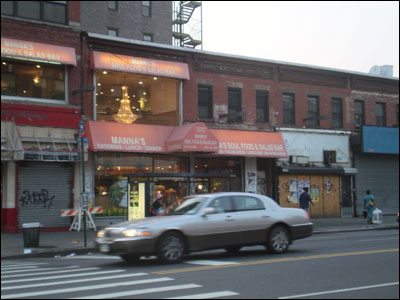
Fighting change
Last summer, Betty Park and the other leaseholders learned that Kimco Realty had purchased their building and intended to demolish it. The deal was brokered by Harlem native Eugene Giscombe, of the real estate company Giscombe-Henderson, and a board member of Harlem’s Business Improvement District, a taxpayer-supported organization designed to bring jobs into the neighborhood. When asked about the development, Giscombe declined to comment.
Several businesses left the premises immediately, including Bobby’s Happy House next door, among the first African American–owned businesses in Harlem. But Manna’s and its remaining neighbors (the House of Seafood, Victor Body Lawson Architects, the Million Nail Salon, and Rotiplus Caribbean Cuisine) coalesced into the Save Harlem Association. Together they hired Adam Leitman Bailey, a prominent Manhattan real estate attorney, hoping to obtain an injunction against Kimco and prevent their eviction.
“My opinion is that Kimco does not respect how long we have been here,” says Park. “We want to take them to court.”
Park, a New Jersey resident and emigrant from Korea, opened Manna’s on the heels of the 1984 riots, which were directed against Korean merchants operating in the area. Although a self-described “new kid on the block” at the time, Park says she recognized that in order for a Korean American–owned business to gain acceptance in Harlem, it had to both appeal to and hire people from the community. One African American employee born in the South — who left Manna’s in the early ’90s — showed her how to make the “soul food” for which Park’s restaurant became known. In need of more space, Manna’s moved to its current Eighth Avenue address from its original spot around the corner. Two more Manna’s opened in Harlem: one in 1990 and the other six years later, both on the south side of 125th Street, to the east of Lenox Avenue and at the corner of Madison respectively.
According to Bailey, Kimco’s representatives claimed in an early settlement meeting that they planned to build a four-story community center on the location. However, on November 15, 2007, Kimco ran an ad in The New York Amsterdam News for a much larger retail center called “Harlem Plaza” to be built on the site. He also states that his clients were collectively offered $100,000 to leave by January — an offer Kimco has since retracted.
“They are liars and they keep on lying,” says Bailey, a brash-voiced and energetic gentleman.
Fred Winters, a spokesman for Kimco, asserts that the real estate company has intended from the outset to construct a large retail building on the site with office space available on its upper levels, some of which would be allocated for community use. He calls the $100,000 figure “grossly understated,” insisting that Kimco’s actual offer was far greater. It was withdrawn, he says, because the business owners brought suit against Kimco. Winters promises that the Harlem Plaza will bring innumerable economic advantages to the area, providing employment both in its construction and in the new businesses it will attract to the neighborhood.
“The [existing] building is old, and Kimco wants to build a building that is new and modern,” Winters says.
Bailey argues that Kimco’s project will have a devastating effect on the neighborhood’s character, saying further that the development will take years to complete, reducing the 125th Street and Eighth Avenue hub to a “parking lot.” His legal case rests on the fact that the Save Harlem Association’s members signed their leases with the building’s previous owner with the understanding that they would not be evicted and the building demolished, granting them legal protection from Kimco’s plans for the spot. In addition, the lease included a provision waiving the right to judicial review, which Bailey believes should render it void under New York State law.
Bailey’s law firm has drafted a piece of legislation that would declare all of 125th Street — also called Dr. Martin Luther King, Jr. Boulevard — a historic district, preventing any further development along the thoroughfare. Bailey views his work in the area as an extension of the civil rights activism based out of Harlem in the 1960s, and of the prototypical American enthusiasm for “underdogs.”
Winters, who lives only five blocks from the Plaza’s prospective address, considers the possibility of damage to Harlem’s authenticity “a very complex debate” that he prefers not to comment on.

Harlem locals say…
The accelerated gentrification of Harlem over the past decade has left many natives feeling pinched between rising rents and changes to the neighborhood’s appearance and demographics that have come with the upswing in apartment building construction. Added to that in the past year have been Columbia University’s city-approved plan to convert a 17-acre tract of Harlem’s Manhattanville area into campus buildings — while demolishing most of the existing structures, including 132 apartments — as well the rezoning of 125th street to permit further high-rise and residential development.
Assistant Manager Philip Bulgar, who has worked at Manna’s now-imperiled address since 1996, recalls first hearing about Kimco’s purchase last March. He is clearly angry, and is voluble in expressing his indignation.
“This store has been here since 1991,” Bulgar says, referring to the restaurant’s current location. “It has been one of the cornerstones of the community for a long time. We service the community and we give jobs to people in the community.”
He points to Manna’s diverse staff, a group of 20 individuals drawn entirely from the neighborhood, and that includes among its number immigrants from Africa and Mexico. Bulgar believes that new retail developments, like Harlem Plaza, will neither hire nor cater to locals. Moreover, he sees it as part of the wide-scale gentrification of the area, which he calls “ugly” and “immoral.”
“I was here in the ’90s, when Harlem was bad,” says Bulgar, recalling the neighborhood’s past problems with drugs, gangs, and petty crime. “You couldn’t give away a building in Harlem in those days. But today, Harlem is safer and cleaner than ever before.” He points out that last year, Harlem’s 28th Precinct won an award for its safety, but asks “at what cost?”
Nonetheless, Bulgar admits he prefers Harlem’s present situation to its previous one. And while he concedes that upscale development will make the neighborhood “look nicer,” he argues that “it will be artificial, very artificial.”
“A lot of businesses are going to be gone and a lot of people will lose their jobs,” Bulgar asserts. “These small businesses reflect people’s dreams and lives. And I guarantee that people will miss this.
“This is not some corporate store,” he continues, characterizing Manna’s approach to business as “people-oriented and hands-on.” Bulgar mentions a nearby Disney Store that went out of business “without anybody noticing.”
Operating the register, Bulgar — a Harlem native who lives just blocks away from his place of employment and whose daughter attends nearby City College of New York — appears comfortable and familiar with nearly all of Manna’s customers, addressing most of them like old friends. One patron invites Bulgar to his new Washington Heights apartment, which he selected for its high ceilings and its location in a vintage building. The two men spend a few moments discussing the superior merits of pre-World War II architecture.
Other customers have their own comments about the changes in their neighborhood.
“Columbia’s taking over,” one woman complains, referring the university’s increasing incursions into West Harlem. “I’m ashamed that I work for them.”
“It’s not your fault,” Bulgar assures her. “You’re not the one who makes the policy.”
“You know that in 25 years, Harlem’s going to be mostly white,” another customer, a light-skinned African American man, declares. “Seventy-five percent white and just 25 percent black.”
Noting the current rate of gentrification to the neighborhood, Bulgar estimates the interval will be closer to five years.
“Look at this,” Bulgar exclaims, gesturing out the window toward a new Soho North building on 123rd Street. “None of this was here a year ago — these condos and everything. It’s happening faster than people even realize.” He laments what he sees as obliviousness and indifference on the part of many Harlemites.
“Most of the people here are unaware of what’s going on, unaware or apathetic. They think, you know, ‘what can you do?’”
Condominiums like the one noted by Bulgar are sprouting up all over south Harlem — or as it has come to be known in real estate circles, SoHa. And with the new zoning laws, the trend is only going to continue. Proponents of the rezoning include the owners of the Apollo Theater and Congressman Charles Rangel, himself a frequent Manna’s customer. They assert that the construction of new buildings and the importation of chain stores will further rejuvenate the neighborhood.
Manager David Taylor has a different idea of why Harlem politicians are supporting City Hall’s plans.
“We live in a community where our leaders can be bought,” Taylor says. “Our leaders don’t work for us.”
“What they’re saying is that the Harlem of old has no future,” Bulgar remarks. “A lot of these properties, the condominiums, they are going to cost half a million dollars. Now, the median income in Harlem is $27,000 a year. Who’s going to live here?”
Postlude
In the unisex bathroom on the upper level, a number of visitors to the Eighth Avenue Manna’s have written their thoughts on the wall.
“Harlem is state of mind and spirit. If you work hard enough and with the right spirit you can get Harlem back.”
“HARLEM IS OUR Promised LAND. Think about it!!”
“Black people in Harlem could have owned Harlem but they gave it away!! Now think About that!!”
Written in reply: “No one owns the earth.”
And as commentary on its predecessor: “he who has might has Right.”
And a final quip, punctuated with a smiley face: “Lease :)”
On June 11, 2008, Kimco Realty settled with the Save Harlem Association for an undisclosed sum. According to the agreement, the tenants must vacate the building by September 30 of this year. Most have left already. Manna’s continues to operate out of the 125th and Eighth Avenue location, and will relocate one block northward — to 126th and Eighth Avenue — sometime this winter.
Will Bredderman
Dear Reader,
In The Fray is a nonprofit staffed by volunteers. If you liked this piece, could you
please donate $10? If you want to help, you can also:

